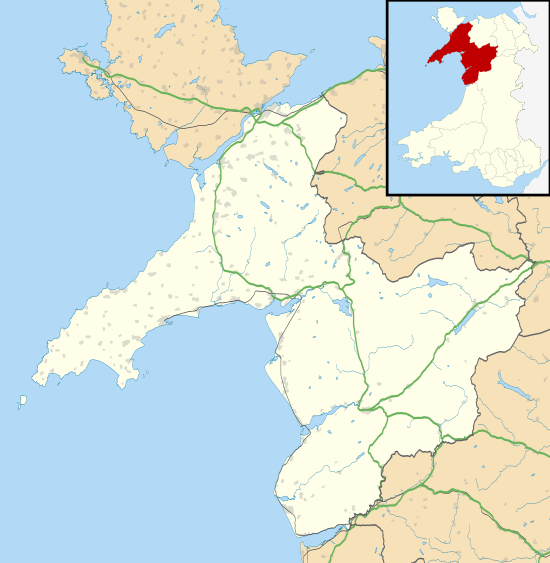Nyth-y-Gigfran quarry
Nyth-y-Gigfran quarry (sometimes spelt: Nith-y-Gigfran or Nidd-y-Gigfran; sometimes known as Glan-y-Pwll quarry) was a slate quarry in the town of Blaenau Ffestiniog, North Wales. It was located about 300 feet (91 m) above the settlement of Glan y Pwll, south of what was to become Blaenau Ffestiniog. The quarry was sited on the steep cliffs that form the eastern edge of Allt-fawr and was entirely underground.[1] The quarry opened c.1846 and became part of the Oakley quarry in the 1880s; this in turn closed in 1969.
 The cliffs of Nyth-y-Gigfran with the quarry incline and waste tips visible | |
| Location | |
|---|---|
 Nyth-y-Gyfran quarry Location in Gwynedd | |
| Location | Blaenau Ffestiniog |
| County | Gwynedd |
| Country | Wales, UK |
| Coordinates | 52°59′47.87″N 3°57′12.53″W grid reference SH6891046186 |
| Production | |
| Products | Slate |
| Type | Underground Quarry |
| History | |
| Opened | c.1840 |
History
Nyth-y-Gigfran opened around 1840, operated by Thomas James.[1]
In 1861 the Glan-y-Pwll Slate & Slab Company Ltd. was incorporated to work the quarry. In 1867 the incline was constructed to connect to the Ffestiniog Railway. The quarry closed in 1870, with the company going into liquidation two years later. [1] After this failure the owning company was acquired by the owners of the neighbouring Oakeley quarry which was mining the north slopes of Allt-fawr. After the amalgamation, the Nyth-y-Gigfran and Oakeley workings were joined together underground and the Nyth-y-Gigfran chambers were worked through to Oakeley.[1] Thus Nyth-y-Gigfran became part of the largest underground slate mine in the world,[2] and was worked until Oakeley closed in 1969.[3]
Geology
Description
Transportation
In 1867, a long, single pitch incline was constructed to connect the quarry with the Ffestiniog Railway at Groesffordd. Slate from Nyth-y-Gigfran was shipped via the railway to the Maenofferen quarry's wharf at Porthmadog Harbour. The incline fell out of use when the quarry closed in the 1880s.[1]
The incline was unusual because it did not connect to the adits of the quarry; it stopped about 100 feet (30 m) below that level because the mountain was too steep above this point. A steeper wooden sledway was used to lower slate down from the adit to the incline winding house. There, on a narrow platform built on the mountain slope, it was loaded onto slate waggons which were lowered to the Ffestiniog Railway.[1]
References
- Boyd, James I.C. (1975) [1959]. The Festiniog Railway 1800 - 1974; Vol. 2 - Locomotives and Rolling Stock; Quarries and Branches: Rebirth 1954-74. The British Narrow Gauge Railway. Blandford: The Oakwood Press. ISBN 978-0-85361-168-4. OCLC 874117875. B1B.
- Jones, R. Merfyn (1981). The North Wales Quarrymen, 1874–1922 (Studies in Welsh history; 4.). University of Wales Press. ISBN 0-7083-0776-0.
- J.G. Isherwood (1980). Candles to Caplamps: the Story of Gloddfa Ganol. Gloddfa Ganol.